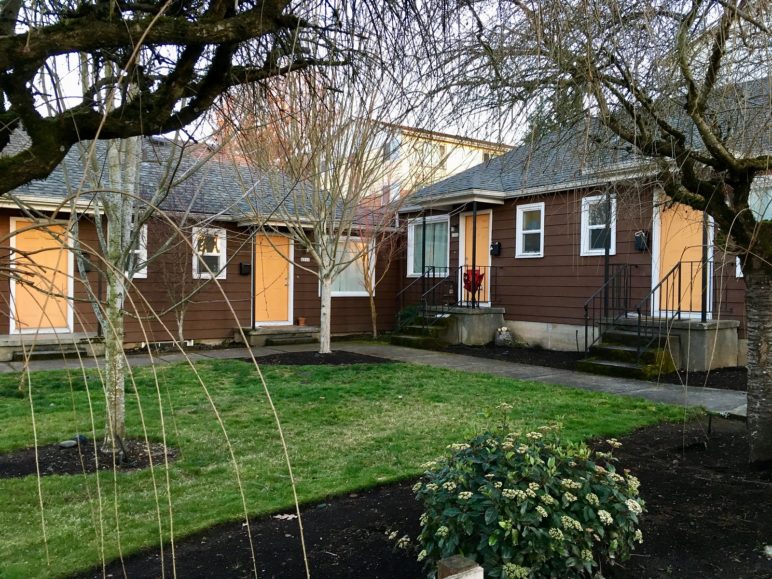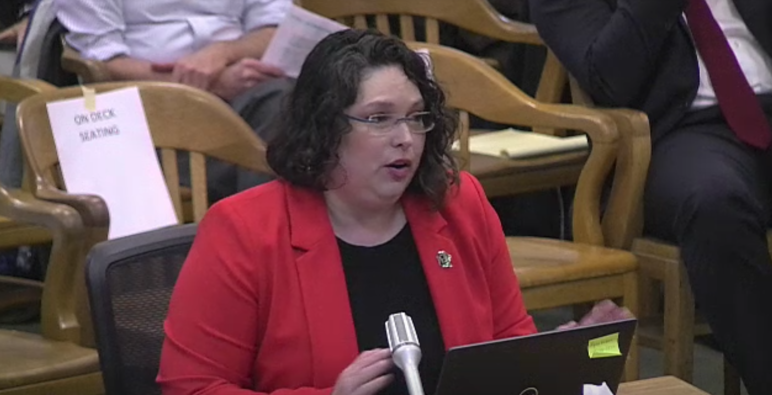Oregon legislators took a historic leap toward greener, fairer, less expensive cities Sunday by passing the first law of its kind in the United States or Canada: A state-level legalization of so-called “missing middle” housing.
If signed by Gov. Kate Brown in the next month, House Bill 2001 will strike down local bans on duplexes for every low-density residential lot in all cities with more than 10,000 residents and all urban lots in the Portland metro area.
In cities of more than 25,000 and within the Portland metro area, the bill would further legalize triplexes, fourplexes, attached townhomes, and cottage clusters on some lots in all “areas zoned for residential use,” where only single-detached houses are currently allowed.
Or, as some more dramatic headlines have summarized it: The bill bans single-family zoning.
Bipartisan support in a deeply divided state

HB 2001 sailed through the House two weeks ago by 43-16, with two-thirds of both the Democratic and Republican caucuses in support. On Sunday, after reconvening from a last-minute Republican walkout that killed a major cap-and-trade bill and also nearly derailed this vote, the Senate followed, 17-9. (The Senate party split was 14-4 in the Democratic caucus, 3-5 in the Republican caucus.)
“This is about choice,” said Rep. Tina Kotek, the Democratic speaker of Oregon’s house and the bill’s architect and lead champion, when she introduced the bill in February. “This is about allowing for different opportunities in neighborhoods that are currently extremely limited.”
“We all have an affordable housing crisis in our areas,” said Rep. Jack Zika, a Redmond Republican who supported the bill before a different committee June 11. “This is not a silver bullet, but will address some of the things that all our constituents need. … We have an opportunity now for first-time homebuyers.”
About 2.8 million Oregonians live in jurisdictions affected by the bill. Of those, about 2.5 million live in larger cities and the Portland metro area where up to four homes per lot would become legal; the rest, in mid-size cities where only duplexes would be legalized.
Cities would retain the ability to regulate building size and design, giving them leeway to ensure that change will be gradual. Cities also have flexibility to incentivize projects that create new below-market homes. (Portland, which has been working on its own fourplex legalization for the last four years, is planning to do exactly that, using a sliding scale of size bonuses that lets buildings be slightly larger for each additional home they create, and another bonus if one or more of the homes is offered below market price.)
“Opening up the American Dream”

Smaller, attached homes like duplexes, triplexes, fourplexes, attached townhomes, and two-story apartment buildings were legal throughout most cities until the mid 20th century and remain common in cities of every size, but building more of them was gradually banned from most land in most cities during the era of legally enforced segregation and the rise of auto-oriented development.
Those bans have led to cities sharply divided between two relatively expensive housing types: apartments in tall buildings, and houses on large lots.
The situation makes no sense, Marisa Zapata, a Portland State University land-use professor, told legislators at the bill’s first hearing.
“We’ve ended up without a rational basis for a zoning code that has single-family on one extreme and multi-family as a high-intensity … dense use,” Zapata said.
Instead, Zapata praised “the idea of trying to integrate duplexes, triplexes, skinny homes, ADUs and cottage clusters into the fabric of single-family homes, hopefully opening up the American Dream to more people.”
House Bill 2001 would help more mid- and lower-income families achieve homeownership, said Steve Messinetti, CEO of the Portland-area chapter of Habitat for Humanity.
In Portland, Messinetti said, his nonprofit organization builds homes mostly on the tiny patches of land where duplexes and triplexes are still legal. He said sharing land is the only way to get development costs low enough to serve “folks making $30,000 to $40,000 a year who are doing everything right but just can’t afford a place to live.”
“There’s a lot of builders out there who want to do good and want to make the sort of houses people need, but you just can’t make a 1,000-square-foot home pencil on a $200,000 piece of property,” Messinetti said.
Habitat and other nonprofit affordable housing developers, coordinated by the Oregon Housing Alliance, became early and crucial backers of the bill.
Some opponents warned of “wholesale redevelopment,” others of no effect
The bill also drew plenty of opposition: for example, from Joe Dudman of Eastmoreland, a close-in enclave that was one of the first Portland areas to ban attached housing.
Today, Zillow puts Eastmoreland’s median home price at $733,000, thanks in part to a beautiful public golf course and a recently built light-rail line nearby.
“HB 2001 will encourage wholesale redevelopment of existing neighborhoods, and the eventual elimination of most single-family houses,” Dudman wrote to legislators in one of 292 pieces of testimony formally submitted to the bill’s committees since February. “Quality of life will plummet.”
Also in opposition was the city council of Eugene, which passed a resolution explicitly opposing the bill; a city staffer wrote, “we do not believe HB 2001 will result in more units on the ground.” The Oregon League of Cities, a group whose lobbyist Erin Doyle said will generally “avoid preemption of local authority with everything we have,” pushed against the bill, too.
On the other side were AARP of Oregon, which said middle housing makes it easier to age in place; The Street Trust, a transportation group that argued HB 2001 would let more people live near good transit and walkable neighborhoods; 1000 Friends of Oregon, which said the law would advance the state’s long fight against exclusionary zoning; Pablo Alvarez of Lane County NAACP, who said the bill would start to undo some of the ways racism has undermined housing affordability for all; Sunrise PDX, which called energy-efficient housing an essential way to fight climate change; and Portland Public Schools, which described the bill as a long-term way to reduce school segregation.
“There is ample research to show that student outcomes improve when schools are more balanced by race/ethnicity and income,” wrote the school district’s lobbyist, Courtney Westling.
(In case it’s not obvious, we at Sightline were among the supporters, too.)
Bans on attached housing: “a thing of the past”

Oregon’s Sunday vote puts the Pacific Northwest clearly at the front of a multinational movement to improve affordability, equity, and sustainability with reform to urban zoning—especially low-density areas.
Duplexes were declared legal on 99 percent of residential lots in Vancouver, BC, last September. Tigard, Oregon, legalized courtyard apartments, cottage clusters and de-facto duplexes on almost every lot, plus fourplexes on almost every corner, in November. On Monday, Seattle seems likely to legalize up to two accessory dwellings, each up to 1,000 square feet, on every lot. And the City of Portland could pass its city-level fourplex legalization by the end of 2019.
Cascadia’s progress is part of a larger wave. Minneapolis legalized triplexes on every lot last fall; that inspired Charlotte, North Carolina to consider the same. In California, where one secondary cottage is already legal on almost every residential lot in the state, Assembly Bill 68 would raise that to two. Earlier this month, the New York Times dedicated a long, reported Sunday editorial to supporting such proposals to re-legalize these options for lower-density living.
In the end, this issue is less complicated than most land-use questions, said Deborah Kafoury, chair of the Multnomah County Commission, in her February testimony endorsing the bill.
“Oregon is a great state to live; we have a lot of people who are moving here; we don’t have enough housing for them, so the cost of housing skyrockets,” Kafoury said. “House Bill 2001 addresses this challenge head-on by allowing more homes to be built in highly restrictive neighborhoods.”
“I am lucky enough to live in one of these single family homes in one of these neighborhoods, and I understand the impulse to want to preserve it,” she went on. “But it’s time to accept that single-family zoning is a thing of the past. Because restricting where people live by virtue of their income has never been OK. It shouldn’t be OK now.”
Michael Andersen, senior researcher, has been writing about ways better municipal policy can help break poverty cycles, with a focus on housing and transportation, for over a decade. His work before joining Sightline included reporting and editing for print and web in Longview and Vancouver, WA, and Portland, OR, where he worked as news editor of BikePortland.org; writer for the pro-housing coalition Portland for Everyone; and infrastructure staff writer for PeopleForBikes, the largest national biking advocacy organization. He has an English degree from Grinnell College and a journalism degree from Northwestern. Find his latest research here. If you have questions or would like to make a media inquiry, contact Sightline Communications Associate Kelsey Hamlin.


Comments are closed.